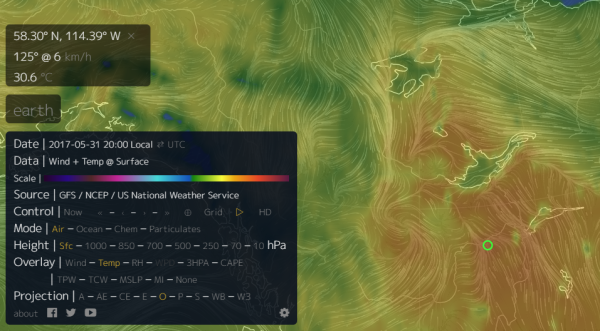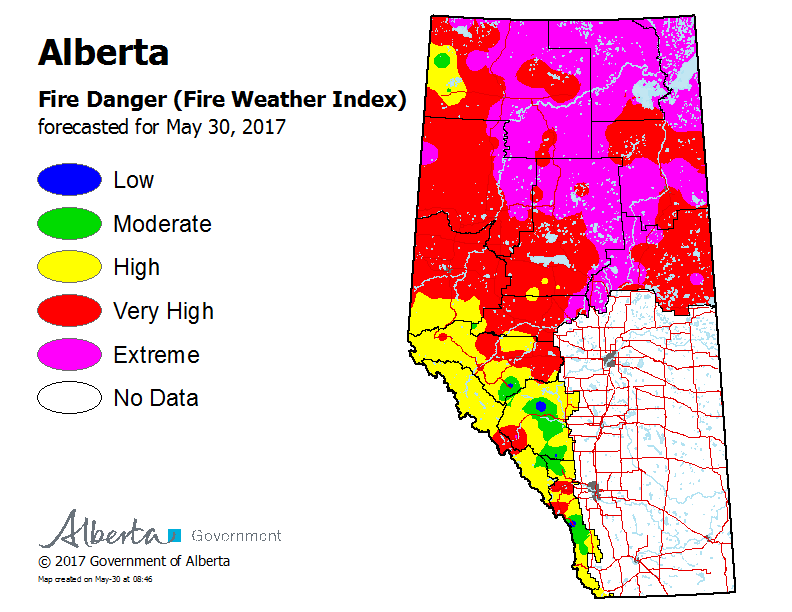Record Heat Predicted for Fort McMurray Wednesday as Fire Danger Spikes
30
May, 2017
Just
a little more than one year after freakish
global warming-spurred wildfires forced a near complete evacuation of
the tar sands production town of Fort McMurray, Alberta,
record heat and extreme fire hazard are again settling in over this
subarctic region.
(Subarctic
sections of Alberta are expected to experience temperatures in the
upper 80s and lower 90s [F] tomorrow. Such heat is expected to spike
fire dangers throughout the region. Image source: Earth
Nullschool.)
The
weather forecast for Wednesday, May 31, 2017 tells
a story of predicted extreme heat for a typically cool region of
Northwest Canada. High temperatures for the day are expected to range
from 86 to 90 F (30 to 32 C). That’s a hot day anywhere. But it’s
particularly impressive for a region that shares a common climate
with places like historically cold Alaska and Hudson Bay.
Average
high temperatures for Fort McMurray in Alberta, Canada for this time
of year typically top out at a rather cool 64 degrees Fahrenheit (18
C) — closer to the expected Wednesday morning low of 62 F (17 C).
Wednesday’s forecast high, meanwhile, is quite considerably outside
the normal range and exceeds 30 year averages by fully 22 to 26
degrees F. If such heat does emerge, it will tie or break the
2007 all-time record for May 31 of 86 F (30 C).
Such record heat is now predicted to occur after today’s
expected, well above average, high of 80 F (26 C).
(A
spike in fire hazard early this week coincides with predicted record
temperatures across Alberta. Image source: Alberta
Fire.)
Unseasonable
warmth — which deepened over the weekend and is expected to peak by
Wednesday — is presently resulting in spiking fire dangers for the
region.
According to the government of Alberta, fire risk for Fort McMurray is now listed as very high through Wednesday due to above average to near record high temperatures and low humidity. Fire hazard for a large swath of Northern Alberta is now also rated very-high-to-extreme.
According to the government of Alberta, fire risk for Fort McMurray is now listed as very high through Wednesday due to above average to near record high temperatures and low humidity. Fire hazard for a large swath of Northern Alberta is now also rated very-high-to-extreme.
It
is worth noting that
the overall fire situation for Canada to-date is presently
much-improved from 2016.
Last year, extreme warmth combined with high winds and dry conditions
to fuel an unusually large fire outbreak over Central and
Northwestern Canada during mid-to-late May. This year, wetter than
normal conditions have suppressed fire activity over much of Canada
over the same seasonal period. And we have some regions in British
Columbia that
are now experiencing evacuations due flooding rivers.
(Wildfires
are flaring over British Columbia even as rapidly rising temperatures
are causing large snow packs to melt far more swiftly than normal.
Such heat and rapid melt is producing a dual threat of flood and fire
at the same time. Image source: BC
Wildfire Service.)
Rising
fire risks coinciding with hot and dry conditions are coming at the
same time that this year’s moisture-engorged snow packs are melting
at far faster than normal rates. Large
fires are thus breaking out in British Columbia and along the Alberta
border as heat and dryness spread northward even
as creek and lake levels in places like Okanagan, BC are facing the
highest flood stages ever recorded.
Overall,
despite 2017’s rainy spring weather, the tale is still one of
unusual warmth. May
temperatures have ranged from 2 to 6 degrees Celsius above average
over Northern and Central Canada during
2017. Such departures are in keeping with the
ongoing trend of rapid warming in the upper Latitudes of the Northern
Hemisphere.
A trend that has considerably worsened overall fire hazard by
lengthening the fire season, by adding new fuels for fires, and by
increasing the number of lightning strikes which help to provide
ignition sources for wildfires. A warming that is directly caused by
ongoing human fossil fuel burning and by related activities such as
the tar sands extraction that continues unabated in Alberta.
Links:
About
a year ago Paul Beckwith and I had a discussion on the fires at Fort
McMurray






No comments:
Post a Comment
Note: only a member of this blog may post a comment.